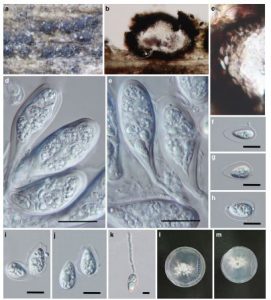Neodeightonia microspora D.Q. Dai & K.D. Hyde, sp. nov. Index Fungorum number: IF552019
Etymology: In reference to the small ascospores
Holotype: MFLU 15–1201
Saprobic on dead bamboo culms. Sexual morph: Ascostromata 100–150 μm high, 95–150 μm diam., dark brown to black, immersed under epidermis to erumpent, solitary, visible as minute black dots or papillae on host tissue, uni-loculate, locules globose to subglobose or fused, coriaceous, vertically orientated to the host surface, with a central ostiole. Peridium 15–20 μm wide, comprising several layers of cells, with relatively thick brown to black walls of textura angularis, broader at the base. Hamathecium comprising only asci. Asci 70–110 × 14–20 μm (x = 90.8 × 18.5 μm, n = 20), 8– spored, bitunicate, fissitunicate, clavate to cylindro-clavate, with a 25–45 μm long pedicel, apically rounded, with a well-developed ocular chamber. Ascospores 10–12 × 4.5– 6 μm (x = 10.5 × 5.4 μm, n = 30), 2–3-seriate, hyaline, aseptate, obovoid, usually wider at the apex, thick-walled, surrounded by a distinctive, structured, mucilaginous sheath. Asexual morph: Undetermined.
Culture characters: Ascospores germinating on PDA within 24 h and germ tubes produced from apex. Colonies growing fast on PDA, reaching 5 cm in 1 week at 28 °C, under 12 h light/12 h dark, effuse, velvety to hairy, circular, initially white, becoming dark brown to black after 1 week.
Material examined: THAILAND, Payae, Bah Huay Kawkhand, Ampher, on dead culms of bamboo, 31 October 2011, Dong-Qin Dai DDQ00228 (MFLU 15–1201, holotype); ibid. (KUN HKAS88710, isotype), living culture, MFLUCC 11–0483, KUMCC; Chiang Rai, Doi Pui, on dead culms of bamboo, 1 September 2011, Dong-Qin Dai DDQ00111 (MFLU 15–1314, paratype), living cultures, MFLUCC 11–0504.
Notes: Neodeightonia microspora is characterized by clavate to cylindro-clavate asci with long pedicels and small obovoid ascospores, with a thick mucilaginous sheath. The new taxon differs from N. subglobosa and N. palmicola in its smaller obovoid ascospores (10–12 × 4.5–6 μm) as compared to N. subglobosa (ellipsoidal to fusiform, 21–26 × 7.5– 9.5 μm) and N. palmicola (ellipsoidal to fusiform, 23– 31.5 × 8.5–12.5 μm). It also differs in having asci with a long pedicel. In the phylogenic analyses (Fig. 1) N. microspora separates from other Neodeightonia species with high bootstrap support (94/96 % MPBP/MLBP, BYPP value greater than 0.90).

